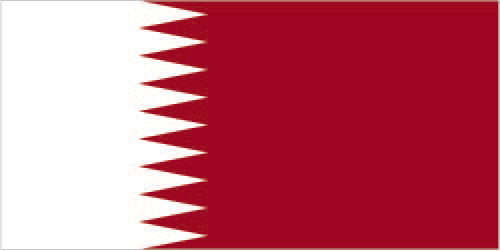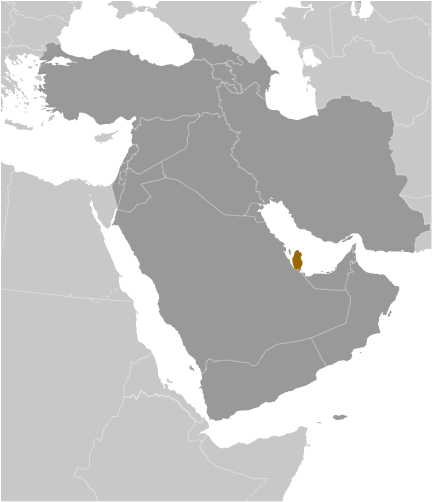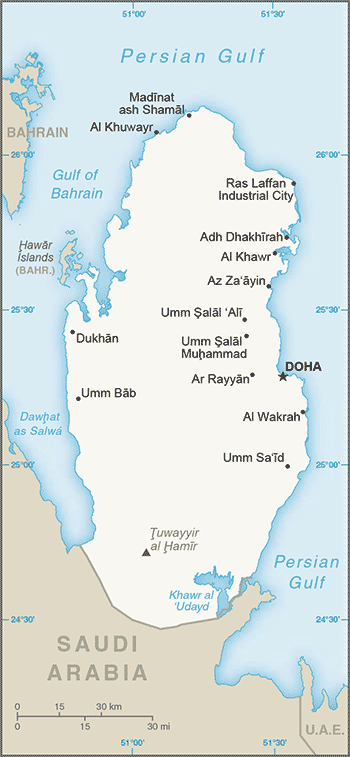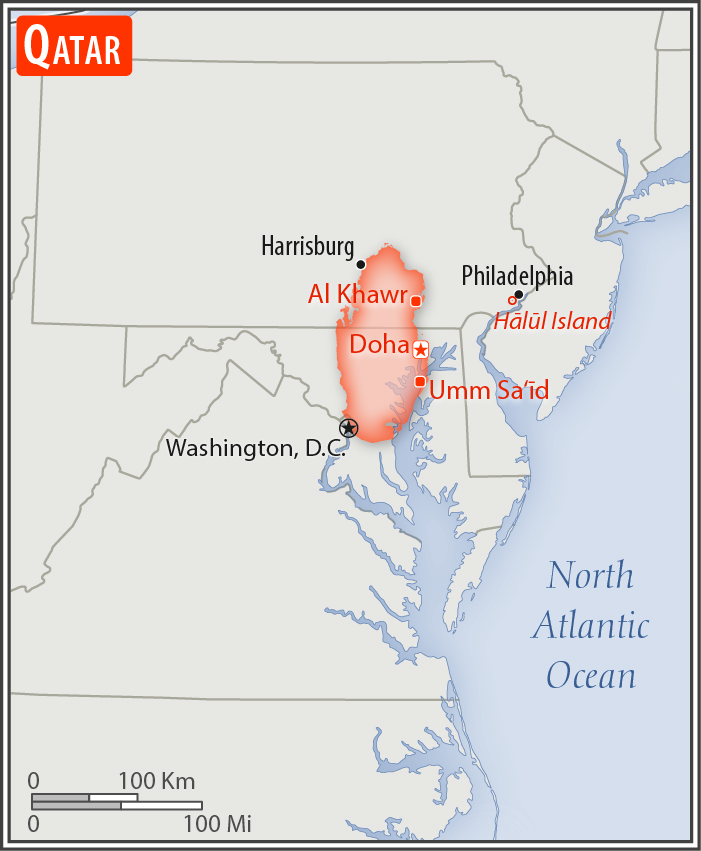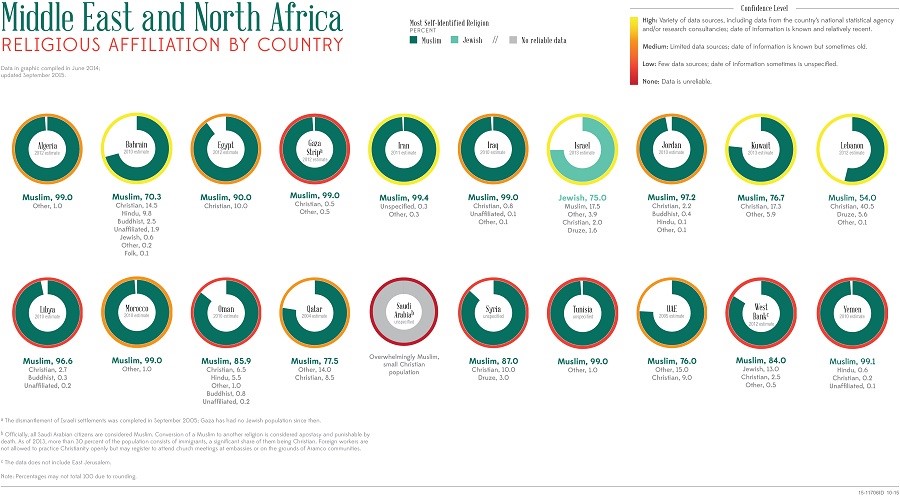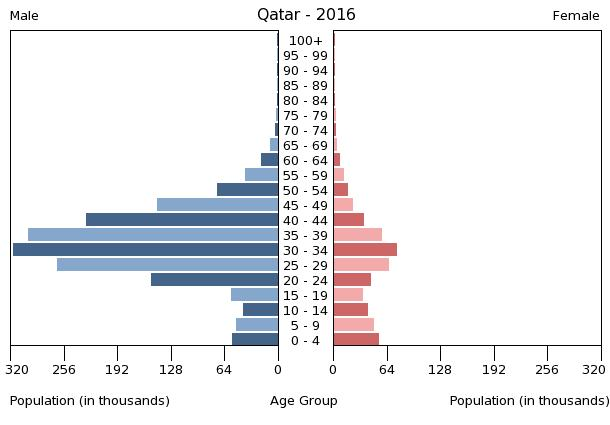Introduction :: QATAR
-
Ruled by the Al Thani family since the mid-1800s, Qatar within the last 60 years transformed itself from a poor British protectorate noted mainly for pearling into an independent state with significant oil and natural gas revenues. The continuous siphoning off of petroleum revenue through the mid-1990s by Qatari amirs permanently residing in Europe had stunted Qatar’s economic growth. Former amir HAMAD bin Khalifa Al Thani, who overthrew his father in a bloodless coup in 1995, ushered in wide-sweeping political and media reforms, unprecedented economic investment, and a growing Qatari regional leadership role, in part through the creation of the pan-Arab satellite news network Al-Jazeera and Qatar's mediation of some regional conflicts. In the 2000s, Qatar resolved its longstanding border disputes with both Bahrain and Saudi Arabia and by 2007 had attained the highest per capita income in the world. Qatar did not experience domestic unrest or violence like that seen in other Near Eastern and North African countries in 2010-11, due in part to its immense wealth. Since the outbreak of regional unrest, however, Doha has prided itself on its support for many of these popular revolutions, particularly in Libya and Syria, although to the detriment of Qatar’s relations with Bahrain, Saudi Arabia, and the United Arab Emirates (UAE), which temporarily recalled their respective ambassadors from Qatar. In mid-2013, HAMAD transferred power to his 33 year-old son, the current Amir TAMIM bin Hamad - a peaceful abdication rare in the history of Arab Gulf states. TAMIM oversaw a warming of Qatar’s relations with Bahrain, Saudi Arabia, and the UAE by later in 2014 and prioritized improving the domestic welfare of Qataris, including establishing advanced healthcare and education systems and expanding the country's infrastructure in anticipation of Doha's hosting of the 2022 World Cup.
Geography :: QATAR
-
Middle East, peninsula bordering the Persian Gulf and Saudi Arabia
25 30 N, 51 15 E
Middle East
total: 11,586 sq km
land: 11,586 sq km
water: 0 sq km
country comparison to the world: 165
almost twice the size of Delaware; slightly smaller than Connecticut
Area comparison map:

Middle East
::QATAR

Area Comparison
almost twice the size of Delaware; slightly smaller than Connecticut
total: 87 km
border countries (1): Saudi Arabia 87 km
563 km
territorial sea: 12 nm
contiguous zone: 24 nm
exclusive economic zone: as determined by bilateral agreements or the median line
arid; mild, pleasant winters; very hot, humid summers
mostly flat and barren desert
mean elevation: 28 m
elevation extremes: lowest point: Persian Gulf 0 m
highest point: Tuwayyir al Hamir 103 m
petroleum, natural gas, fish
agricultural land: 5.6%
arable land 1.1%; permanent crops 0.2%; permanent pasture 4.3%
forest: 0%
other: 94.4% (2011 est.)
130 sq km (2012)
most of the population is clustered in or around the capital of Doha on the eastern side of the peninsula
haze, dust storms, sandstorms common
limited natural freshwater resources are increasing dependence on large-scale desalination facilities
party to: Biodiversity, Climate Change, Climate Change-Kyoto Protocol, Desertification, Endangered Species, Hazardous Wastes, Law of the Sea, Ozone Layer Protection, Ship Pollution
signed, but not ratified: none of the selected agreements
the peninsula occupies a strategic location in the central Persian Gulf near major petroleum deposits
People and Society :: QATAR
-
2,314,307 (July 2017 est.)
country comparison to the world: 143
noun: Qatari(s)
adjective: Qatari
non-Qatari 88.4%, Qatari 11.6% (2015 est.)
Arabic (official), English commonly used as a second language
Muslim 67.7%, Christian 13.8%, Hindu 13.8%, Buddhist 3.1%, folk religion <.1%, Jewish <.1%, other 0.7%, unaffiliated 0.9% (2010 est.)
religious affiliation:

Middle East
::QATAR

0-14 years: 12.63% (male 148,021/female 144,252)
15-24 years: 12.35% (male 206,055/female 79,859)
25-54 years: 70.59% (male 1,359,383/female 274,334)
55-64 years: 3.42% (male 61,051/female 18,203)
65 years and over: 1% (male 14,932/female 8,217) (2017 est.)
population pyramid:

Middle East
::QATAR

Population Pyramid
A population pyramid illustrates the age and sex structure of a country's population and may provide insights about political and social stability, as well as economic development. The population is distributed along the horizontal axis, with males shown on the left and females on the right. The male and female populations are broken down into 5-year age groups represented as horizontal bars along the vertical axis, with the youngest age groups at the bottom and the oldest at the top. The shape of the population pyramid gradually evolves over time based on fertility, mortality, and international migration trends.
For additional information, please see the entry for Population pyramid on the Definitions and Notes page under the References tab.
total dependency ratio: 17.5
youth dependency ratio: 16.3
elderly dependency ratio: 1.3
potential support ratio: 78.1 (2015 est.)
total: 33.2 years
male: 34.3 years
female: 28.1 years (2017 est.)
country comparison to the world: 90
2.27% (2017 est.)
country comparison to the world: 32
9.6 births/1,000 population (2017 est.)
country comparison to the world: 199
1.5 deaths/1,000 population (2017 est.)
country comparison to the world: 226
14.6 migrant(s)/1,000 population (2017 est.)
country comparison to the world: 4
most of the population is clustered in or around the capital of Doha on the eastern side of the peninsula
urban population: 99.4% of total population (2017)
rate of urbanization: 1.63% annual rate of change (2015-20 est.)
DOHA (capital) 718,000 (2015)
at birth: 1.02 male(s)/female
0-14 years: 1.03 male(s)/female
15-24 years: 2.64 male(s)/female
25-54 years: 4.91 male(s)/female
55-64 years: 3.38 male(s)/female
65 years and over: 1.71 male(s)/female
total population: 3.41 male(s)/female (2016 est.)
13 deaths/100,000 live births (2015 est.)
country comparison to the world: 140
total: 6.2 deaths/1,000 live births
male: 6.4 deaths/1,000 live births
female: 5.9 deaths/1,000 live births (2017 est.)
country comparison to the world: 167
total population: 78.9 years
male: 76.8 years
female: 81 years (2017 est.)
country comparison to the world: 52
1.9 children born/woman (2017 est.)
country comparison to the world: 133
37.5% (2012)
2.2% of GDP (2014)
country comparison to the world: 189
1.96 physicians/1,000 population (2014)
1.2 beds/1,000 population (2012)
improved:
urban: 100% of population
rural: 100% of population
total: 100% of population
unimproved:
urban: 0% of population
rural: 0% of population
total: 0% of population (2015 est.)
improved:
urban: 98% of population
rural: 98% of population
total: 98% of population
unimproved:
urban: 2% of population
rural: 2% of population
total: 2% of population (2015 est.)
<.1% (2016 est.)
<100 (2016 est.)
<100 (2016 est.)
35.1% (2016)
country comparison to the world: 15
3.5% of GDP (2014)
country comparison to the world: 154
definition: age 15 and over can read and write
total population: 97.3%
male: 97.4%
female: 96.8% (2015 est.)
total: 13 years
male: 13 years
female: 14 years (2011)
total: 0.6%
male: 0.2%
female: 2.2% (2015 est.)
country comparison to the world: 134
Government :: QATAR
-
conventional long form: State of Qatar
conventional short form: Qatar
local long form: Dawlat Qatar
local short form: Qatar
note: closest approximation of the native pronunciation is gattar or cottar
etymology: the origin of the name is uncertain, but it dates back at least 2,000 years since a term "Catharrei" was used to describe the inhabitants of the peninsula by Pliny the Elder (1st century A.D.), and a "Catara" peninsula is depicted on a map by Ptolemy (2nd century A.D.)
absolute monarchy
name: Doha
geographic coordinates: 25 17 N, 51 32 E
time difference: UTC+3 (8 hours ahead of Washington, DC, during Standard Time)
8 municipalities (baladiyat, singular - baladiyah); Ad Dawhah, Al Khawr wa adh Dhakhirah, Al Wakrah, Ar Rayyan, Ash Shamal, Ash Shihaniyah, Az Za'ayin, Umm Salal
3 September 1971 (from the UK)
National Day, 18 December (1878), anniversary of Al Thani family accession to the throne; Independence Day, 3 September (1971)
history: previous 1972 (provisional); latest drafted 2 July 2002, approved by referendum 29 April 2003, endorsed 8 June 2004, effective 9 June 2005
amendments: proposed by the emir or by one-third of Advisory Council members; passage requires two-thirds majority vote of Advisory Council members and approval and promulgation by the emir; articles pertaining to the rule of state and its inheritance, functions of the emir, and citizen rights and liberties cannot be amended (2016)
mixed legal system of civil law and Islamic law (in family and personal matters)
has not submitted an ICJ jurisdiction declaration; non-party state to the ICCt
citizenship by birth: no
citizenship by descent only: the father must be a citizen of Qatar
dual citizenship recognized: no
residency requirement for naturalization: 20 years; 15 years if an Arab national
18 years of age; universal
chief of state: Amir TAMIM bin Hamad Al Thani (since 25 June 2013)
head of government: Prime Minister ABDALLAH bin Nasir bin Khalifa Al Thani (since 26 June 2013); Deputy Prime Minister Ahmad bin Abdallah al-MAHMUD (since 20 September 2011)
cabinet: Council of Ministers appointed by the amir
elections/appointments: the monarchy is hereditary; prime minister and deputy prime minister appointed by the amir
description: unicameral Advisory Council or Majlis al-Shura (35 seats; members appointed by the monarch)
note: the 2003 constitution calls for a 45-member council with 30 members directly elected by popular vote for 4-year re-electable terms and 15 appointed by the monarch to serve until resignation or until relieved; election for the new Council was initially scheduled for 2007 but has been extended several times, the latest to June 2019
highest court(s): Supreme Court or Court of Cassation (consists of the court president and several judges); Supreme Constitutional Court (consists of the chief justice and 6 members)
judge selection and term of office: Supreme Court judges nominated by the Supreme Judiciary Council, a 9-member independent body consisting of judiciary heads appointed by the Amir; judges appointed for 3-year renewable terms; Supreme Constitutional Court members nominated by the Supreme Judiciary Council and appointed by the monarch; term of appointment NA
subordinate courts: Courts of Appeal; Administrative Court; courts of first instance; sharia courts; Courts of Justice; Qatar International Court and Dispute Resolution Center, established in 2009, provides dispute resolution services for institutions and bodies in Qatar, as well as internationally
political parties are banned
none
ABEDA, AFESD, AMF, CAEU, CD, CICA (observer), EITI (implementing country), FAO, G-77, GCC, IAEA, IBRD, ICAO, ICC (national committees), ICRM, IDA, IDB, IFAD, IFC, IFRCS, IHO, ILO, IMF, IMO, IMSO, Interpol, IOC, IOM (observer), IPU, ISO, ITSO, ITU, LAS, MIGA, NAM, OAPEC, OAS (observer), OIC, OIF, OPCW, OPEC, PCA, UN, UNCTAD, UNESCO, UNIDO, UNIFIL, UNWTO, UPU, WCO, WHO, WIPO, WMO, WTO
chief of mission: Ambassador MISHAL bin Hamad bin Muhammad Al Thani (since 24 April 2017)
chancery: 2555 M Street NW, Washington, DC 20037
telephone: [1] (202) 274-1600
FAX: [1] (202) 237-0682
consulate(s) general: Houston, Los Angeles
chief of mission: Ambassador (vacant); Charge d'Affaires William GRANT (since 23 July 2017)
embassy: 22 February Street, Al Luqta District, Doha
mailing address: P. O. Box 2399, Doha
telephone: [974] 4496-6000
FAX: [974] 4488-4298
maroon with a broad white serrated band (nine white points) on the hoist side; maroon represents the blood shed in Qatari wars, white stands for peace; the nine-pointed serrated edge signifies Qatar as the ninth member of the "reconciled emirates" in the wake of the Qatari-British treaty of 1916
note: the other eight emirates are the seven that compose the UAE and Bahrain; according to some sources, the dominant color was formerly red, but this darkened to maroon upon exposure to the sun and the new shade was eventually adopted
a maroon field surmounted by a white serrated band with nine white points; national colors: maroon, white
name: "Al-Salam Al-Amiri" (The Amiri Salute)
lyrics/music: Sheikh MUBARAK bin Saif al-Thani/Abdul Aziz Nasser OBAIDAN
note: adopted 1996; anthem first performed that year at a meeting of the Gulf Cooperative Council hosted by Qatar
Economy :: QATAR
-
Qatar’s oil and natural gas resources are the country’s main economic engine and government revenue source, driving Qatar’s high economic growth and per capita income levels, robust state spending on public entitlements, and booming construction spending, particularly as Qatar prepares to host the World Cup in 2022. Although the government has maintained high capital spending levels for ongoing infrastructure projects, low oil and natural gas prices in recent years have led the Qatari Government to tighten some spending to help stem a $12 billion budget deficit in 2016 - 7.8% of GDP.
Qatar’s reliance on oil and natural gas is likely to persist for the foreseeable future. Proved natural gas reserves exceed 25 trillion cubic meters - 13% of the world total and, among countries, third largest in the world. Proved oil reserves exceed 25 billion barrels, allowing production to continue at current levels for about 56 years. Despite the dominance of oil and natural gas, Qatar has made significant gains in strengthening non-oil sectors, such as manufacturing, construction, and financial services, leading non-oil GDP to steadily rise in recent years to just over half the total.
$327.6 billion (2016 est.)
$316.4 billion (2015 est.)
$302.3 billion (2014 est.)
note: data are in 2016 dollars
country comparison to the world: 52
$155.8 billion (2016 est.)
2.2% (2016 est.)
3.6% (2015 est.)
4% (2014 est.)
country comparison to the world: 108
$125,100 (2016 est.)
$131,500 (2015 est.)
$139,700 (2014 est.)
note: data are in 2016 dollars
country comparison to the world: 2
44% of GDP (2016 est.)
46.6% of GDP (2015 est.)
55.7% of GDP (2014 est.)
country comparison to the world: 3
household consumption: 25.8%
government consumption: 23.1%
investment in fixed capital: 43.6%
investment in inventories: 1.6%
exports of goods and services: 47.5%
imports of goods and services: -41.6% (2016 est.)
agriculture: 0.2%
industry: 54.6%
services: 52% (2016 est.)
fruits, vegetables; poultry, dairy products, beef; fish
liquefied natural gas, crude oil production and refining, ammonia, fertilizer, petrochemicals, steel reinforcing bars, cement, commercial ship repair
0.6% (2016 est.)
country comparison to the world: 149
1.896 million (2016 est.)
country comparison to the world: 126
0.7% (2016 est.)
0.4% (2015 est.)
country comparison to the world: 3
NA%
lowest 10%: 1.3%
highest 10%: 35.9% (2007)
revenues: $39.67 billion
expenditures: $52.67 billion (2016 est.)
25.3% of GDP (2016 est.)
country comparison to the world: 116
-8.3% of GDP (2016 est.)
country comparison to the world: 193
55.4% of GDP (2016 est.)
42.2% of GDP (2015 est.)
country comparison to the world: 85
1 April - 31 March
2.7% (2016 est.)
1.9% (2015 est.)
country comparison to the world: 136
4.5% (31 December 2012)
4.93% (31 December 2011)
country comparison to the world: 82
4.51% (31 December 2016 est.)
4.5% (31 December 2015 est.)
country comparison to the world: 149
$35.26 billion (31 December 2016 est.)
$34.87 billion (31 December 2015 est.)
country comparison to the world: 58
$136.7 billion (31 December 2016 est.)
$142.2 billion (31 December 2015 est.)
country comparison to the world: 50
$224.2 billion (31 December 2016 est.)
$200.6 billion (31 December 2015 est.)
country comparison to the world: 43
$142.6 billion (31 December 2015 est.)
$185.9 billion (31 December 2014 est.)
$152.6 billion (31 December 2013 est.)
country comparison to the world: 37
$-7.679 billion (2016 est.)
$13.75 billion (2015 est.)
country comparison to the world: 180
$57.25 billion (2016 est.)
$77.29 billion (2015 est.)
country comparison to the world: 46
liquefied natural gas (LNG), petroleum products, fertilizers, steel
Japan 20%, South Korea 15.5%, India 13.1%, China 8.2%, UAE 5.5%, Singapore 5.3% (2016)
$31.93 billion (2016 est.)
$28.5 billion (2015 est.)
country comparison to the world: 60
machinery and transport equipment, food, chemicals
US 13.7%, Germany 9.8%, UAE 9.2%, China 8.6%, Japan 7.2%, UK 5.5%, Saudi Arabia 4.6%, Italy 4.4% (2016)
$31.89 billion (31 December 2016 est.)
$37.26 billion (31 December 2015 est.)
country comparison to the world: 48
$157.9 billion (31 December 2016 est.)
$141.7 billion (31 December 2015 est.)
country comparison to the world: 41
$35.31 billion (31 December 2016 est.)
$34.53 billion (31 December 2015 est.)
country comparison to the world: 64
$57.63 billion (31 December 2016 est.)
$49.73 billion (31 December 2015 est.)
country comparison to the world: 41
Qatari rials (QAR) per US dollar -
3.64 (2016 est.)
3.64 (2015 est.)
3.64 (2014 est.)
3.64 (2013 est.)
3.64 (2012 est.)
Energy :: QATAR
-
population without electricity: 45,165
electrification - total population: 98%
electrification - urban areas: 98%
electrification - rural areas: 93% (2012)
39.01 billion kWh (2015 est.)
country comparison to the world: 59
36.53 billion kWh (2015 est.)
country comparison to the world: 59
0 kWh (2016 est.)
country comparison to the world: 186
0 kWh (2016 est.)
country comparison to the world: 190
8.836 million kW (2015 est.)
country comparison to the world: 67
99.5% of total installed capacity (2015 est.)
country comparison to the world: 30
0% of total installed capacity (2015 est.)
country comparison to the world: 169
0% of total installed capacity (2015 est.)
country comparison to the world: 197
0.5% of total installed capacity (2015 est.)
country comparison to the world: 151
1.523 million bbl/day (2016 est.)
country comparison to the world: 17
1.255 million bbl/day (2014 est.)
country comparison to the world: 14
0 bbl/day (2014 est.)
country comparison to the world: 179
25.24 billion bbl (1 January 2017 es)
country comparison to the world: 14
278,300 bbl/day (2014 est.)
country comparison to the world: 44
280,000 bbl/day (2015 est.)
country comparison to the world: 46
544,000 bbl/day (2014 est.)
country comparison to the world: 15
245.3 bbl/day (2014 est.)
country comparison to the world: 210
164 billion cu m (2015 est.)
country comparison to the world: 4
49.64 billion cu m (2015 est.)
country comparison to the world: 22
123.9 billion cu m (2015 est.)
country comparison to the world: 2
0 cu m (2013 est.)
country comparison to the world: 178
24.3 trillion cu m (1 January 2017 es)
country comparison to the world: 3
92 million Mt (2013 est.)
country comparison to the world: 42
Communications :: QATAR
-
total subscriptions: 467,148
subscriptions per 100 inhabitants: 21 (July 2016 est.)
country comparison to the world: 101
total: 3,552,579
subscriptions per 100 inhabitants: 157 (July 2016 est.)
country comparison to the world: 134
general assessment: modern system centered in Doha
domestic: combined fixed-line and mobile-cellular telephone subscribership exceeds 175 telephones per 100 persons
international: country code - 974; landing point for the Fiber-Optic Link Around the Globe (FLAG) submarine cable network that provides links to Asia, Middle East, Europe, and the US; tropospheric scatter to Bahrain; microwave radio relay to Saudi Arabia and the UAE; satellite earth stations - 2 Intelsat (1 Atlantic Ocean and 1 Indian Ocean) and 1 Arabsat (2016)
TV and radio broadcast licensing and access to local media markets are state controlled; home of the satellite TV channel Al-Jazeera, which was originally owned and financed by the Qatari government but has evolved to independent corporate status; Al-Jazeera claims editorial independence in broadcasting; local radio transmissions include state, private, and international broadcasters on FM frequencies in Doha; in August 2013, Qatar's satellite company Es'hailSat launched its first communications satellite Es'hail 1 (manufactured in the US), which entered commercial service in December 2013 to provide improved television broadcasting capability and expand availability of voice and Internet; Es'hailSat expects to launch its second satellite in 2018 (2014)
.qa
total: 2,129,360
percent of population: 94.3% (July 2016 est.)
country comparison to the world: 95
Transportation :: QATAR
-
number of registered air carriers: 2
inventory of registered aircraft operated by air carriers: 199
annual passenger traffic on registered air carriers: 25,263,224
annual freight traffic on registered air carriers: 7,563,307,390 mt-km (2015)
A7 (2016)
6 (2013)
country comparison to the world: 178
total: 4
over 3,047 m: 3
1,524 to 2,437 m: 1 (2017)
total: 2
914 to 1,523 m: 1
under 914 m: 1 (2013)
1 (2013)
condensate 288 km; condensate/gas 221 km; gas 2,383 km; liquid petroleum gas 90 km; oil 745 km; refined products 103 km (2013)
total: 9,830 km (2010)
country comparison to the world: 136
total: 28
by type: bulk carrier 3, chemical tanker 2, container 13, liquefied gas 6, petroleum tanker 4
foreign-owned: 6 (Kuwait 6)
registered in other countries: 35 (Liberia 5, Marshall Islands 29, Panama 1) (2010)
country comparison to the world: 88
major seaport(s): Doha, Mesaieed (Umaieed), Ra's Laffan
LNG terminal(s) (export): Ras Laffan
Military and Security :: QATAR
-
Qatari Emiri Land Force (QELF), Qatari Emiri Navy (QEN), Qatari Emiri Air Force (QEAF) (2013)
conscription for males aged 18-35; 4-month general obligation, 3 months for graduates (2014)
Transnational Issues :: QATAR
-
none
stateless persons: 1,200 (2016)
current situation: Qatar is a destination country for men, women, and children subjected to forced labor, and, to a much lesser extent, forced prostitution; the predominantly foreign workforce migrates to Qatar legally for low- and semi-skilled work but often experiences situations of forced labor, including debt bondage, delayed or nonpayment of salaries, confiscation of passports, abuse, hazardous working conditions, and squalid living arrangements; foreign female domestic workers are particularly vulnerable to trafficking because of their isolation in private homes and lack of protection under Qatari labor laws; some women who migrate for work are also forced into prostitution
tier rating: Tier 2 Watch List – Qatar does not fully comply with the minimum standards for the elimination of trafficking; however, it is making significant efforts to do so; the government investigated 11 trafficking cases but did not prosecute or convict any offenders, including exploitative employers and recruitment agencies; the primary solution for resolving labor violations was to transfer a worker’s sponsorship to a new employer with minimal effort to investigate whether a forced labor violation had occurred; authorities increased their efforts to protect some trafficking victims, although many victims of forced labor, particularly domestic workers, remained unidentified and unprotected and were sometimes punished for immigration violations or running away from an employer or sponsor; authorities visited worksites throughout the country to meet and educate workers and employers on trafficking regulations, but the government failed to abolish or reform the sponsorship system, perpetuating Qatar’s forced labor problem (2015)







